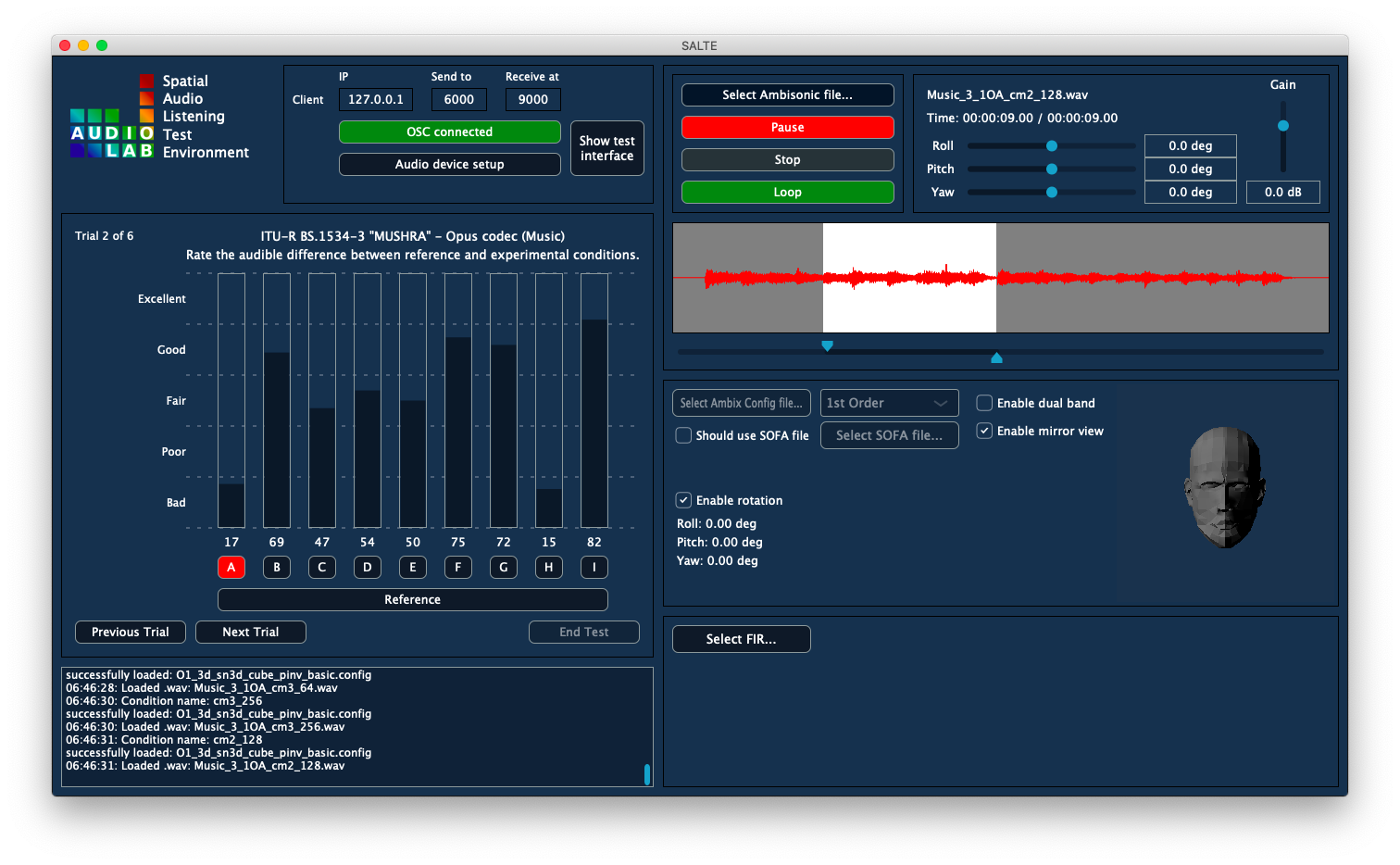SALTE is a listening test software created to aid future research and development of spatial audio systems. The tool consists of a dedicated audio rendering engine and virtual reality interface for conducting spatial audio listening experiments.
Spatial Audio Listening Test Environment (SALTE) can be used in the assessment of:
- Spatial audio recording techniques,
- Spatial audio codecs,
- Binaural rendering algorithms,
- Head-Related Transfer Function (HRTF) datasets,
- Virtual soundscapes and room acoustics.
- Controlled binaural playback of Ambisonic scenes (up to 7th order).
- Head tracking support.
- Built-in flexible listening test interface acommodating standard test paradigms: ITU-R BS.1116, ITU-R BS.1534 ("MUSHRA") and 3GPP TS26.259.
- Networked control of the listening test interface via OSC.
- Support of custom HRTFs contained within separate WAV files or SOFA files.
- FIR-based headphone frequency response compensation.
SALTE Audio Renderer has been programmed in C++ using JUCE audio programming framework. Experimental releases can be obtained here. We would like to encourage users to compile the application themselves based on the latest source code.
- Download Juce.
- Install Visual Studio / Xcode.
- Clone repository.
- Install the required dependencies.
- On Windows add netcdf global path.
- Run Projucer and launch Visual Studio / Xcode.
- Setup Visual Studio Runtime Library to Multi-threaded Debug (/MTd) setting.
- Build.
The location of a libraries folder should be placed relative to the project directory structure as follows:
../Libraries/
../../SALTE-audio-renderer/
-
SOFA C++ API: Source for the libsofa library can be found here. The libsofa directory should be copied to the "Libraries" folder (shown above). This library can then be compiled using Visual Studio/Xcode. It is also required to modify the PATH environment variable to point at the ".dll" location for "netcdf.dll".
-
WDL: Source for a mirror of the WDL library can be found here. The WDL directory should be copied to the 'Libraries' folder (shown above).
-
ASIO SDK (Windows only): To build and run the application as ASIO compliant software the Steinberg license agreement must be agreed to and signed, and then the ASIO SDK should be download from here and its path set in the Projucer settings.
After starting the app, the user has to choose the listening test config file (JSON) path as well as CSV file path where the results will be saved after completion of the test. Both paths are saved in a temporarily settings file at the app shutdown, so they can be recalled at the subsequent application launch. To begin the test, enter participant's ID and click Begin. SALTE Audio Renderer can be run in a participant interface mode in which diagnostic information is hidden and only the necessary controls and information are displayed. The results are saved into the CSV text file once the user decide to end the experimental session (by clicking End Test).
The JSON config file consists of individual settings for each of the test trials. Config file for simple listening test consisting of single trial based on the ITU-R BS.1116 recommendation is presented below.
{
"trials": [
{
"id": "BS1116_speech1_3OA",
"name": "ITU-R BS.1116-3 - Opus codec (Speech)",
"instruction": "Rate the audible impairement of the experimental conditions.",
"scenefolder": "AmbisonicScenes",
"ambixconfigfolder": "SADIE_II_selected_HRTFs",
"MushraReference": [
{
"name": "reference",
"source": "Speech_1_3OA_uncomp.wav",
"order": 3,
"ambixconfig": "KU100/O3_3d_sn3d_26Leb_pinv_basic.config",
"gain": 0
}
],
"MushraConditions": [
{
"name": "hid_reference",
"source": "Speech_1_3OA_uncomp.wav",
"order": 3,
"ambixconfig": "KU100/O3_3d_sn3d_26Leb_pinv_basic.config",
"gain": 0
},
{
"name": "compressed_256kbps",
"source": "Speech_1_3OA_cm2_256.wav",
"order": 3,
"ambixconfig": "KU100/O3_3d_sn3d_26Leb_pinv_basic.config",
"gain": 0
}
],
"ratings": [
"Imperceptible",
"Perceptible, but not annoying",
"Slightly annoying",
"Annoying",
"Very annoying"
]
}
]
}We recommend downloading the example test session which includes more complex test configurations. This package consists of the config file, Ambisonic scenes, ambiX Ambisonic decoder config files and HRTFs.
Head tracking data can be sent to the renderer via OSC messages containing three arguments (Euler angles) representing head rotation, according to the following pattern:
"/rendering/htrpy", float roll, float pitch, float yaw
If you would like to try SALTE Audio renderer without VR headset, you can use this DIY head tracker project.
An example of MATLAB code for basic statistical analysis using box plots can be found here.
Select audio device. If you are using the SALTE VR interfce, make sure that the OSC settings are matching your systems configuration.
SALTE is a collaborative and open source software project. We would like to encourage other researchers to use the framework and participate in its further development. Please contact us if you have any ideas and suggestions how this tool could be improved.
- Tomasz Rudzki, email: tr837@york.ac.uk
- Chris Earnshaw, email: chris.earnshaw@york.ac.uk
GNU General Public License v3.0
-
Ambisonic rotation is based on the IEM Plugin Suite implementation which can be found here.
-
Selected KU100 HRTFs obtained from the SADIE II database.
@conference{rudzki2019salte,
title = {SALTE Pt. 2: On the Design of the SALTE Audio Rendering Engine for Spatial Audio Listening Tests in VR},
author = {Rudzki, Tomasz and Earnshaw, Chris and Murphy, Damian and Kearney, Gavin},
booktitle = {Audio Engineering Society Convention 147},
month = {Oct},
year = {2019},
url = {http://www.aes.org/e-lib/browse.cfm?elib=20560}
}
SALTE is an experimental tool which is in its early stage of development and may contain bugs. Please be aware that it may break anytime during runtime and users might experience unpleasant and loud noises.
